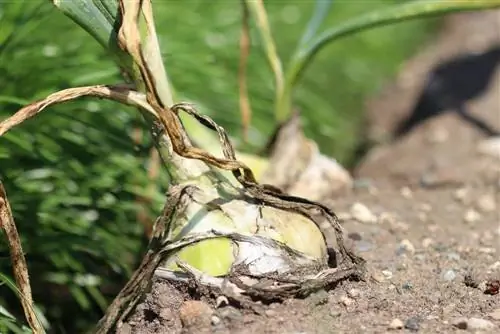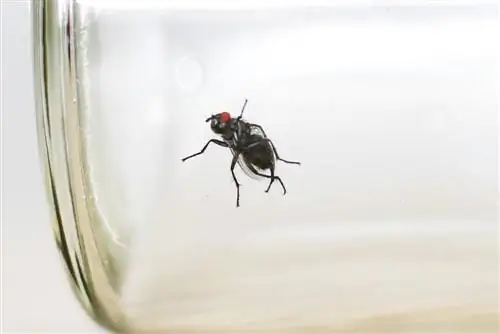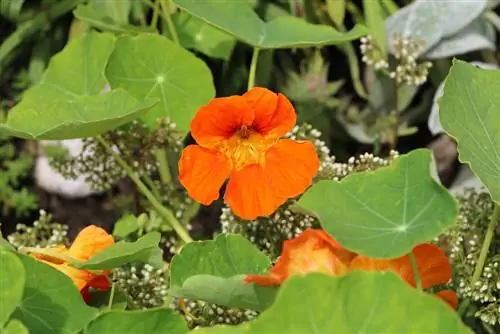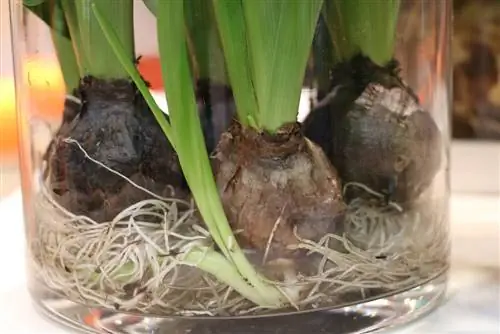- Author admin [email protected].
- Public 2023-12-17 03:39.
- Last modified 2025-01-24 12:45.
The anticipation of young onions, tender leeks and hearty chives is quickly gone when the onion fly strikes. The tiny insect specializes in damaging onion plants. It is primarily the larvae that cause smelly feeding passages in the crops. With up to three generations per season, the pests make life difficult for hobby gardeners. The following profile gets to the heart of all the depressing details. Good to know that various sprays are available to combat it.
Profile
- Insect family of flower flies (Anthomyiidae)
- Genus: Onion fly
- Gray-black insects up to 7 mm long
- Adult larvae up to 10 mm long
- Up to 3 overlapping generations
- Temperature optimum 20 degrees Celsius and higher
- Overwintering as a pupa in the ground
- Life expectancy up to 4 months
Lifestyle
Effective control of onion flies is based on knowledge of their lifestyle. From April onwards, every walk through the vegetable patch should be accompanied by a check for infestation. At this time, the overwintered pupae emerge from the ground to feed on dandelions or cow parsley. Once the females have strengthened themselves sufficiently, they lay their eggs, from which the first generation of voracious larvae develops. To lay their eggs, they specifically look for the proximity of young onion plants so that the hatched larvae feed on the tender roots and shoots. The result is an early death of the young plants. This nefarious activity continues in July when the second generation goes to work, followed by a third plague in August/September. Since the plants have grown in the meantime, the infestation is less noticeable and is better tolerated by the onion plants.
Tip:
The beginning of the dandelion blossom visually signals the first emergence of onion flies.
malicious image
Since the tiny insects and larvae cannot always be seen with the naked eye, the damage is considered an important indication of the presence of the onion fly. What you should pay attention to:
- In the seed row, onion and leek plants wilt immediately after emergence
- As the larvae progress, they move on to shallots, garlic or chives
- The young plants are soft, rot and can be pulled out of the ground without any effort
- Whitish maggots can be seen in the root area and near the ground
Pupation takes place after about 3 weeks, but outside the host plant. If you rake through the bed soil, the 6 mm small dolls may emerge from the soil.
Sprays
In view of the high infestation pressure, hobby gardeners often only have the option to use an insecticide approved for allotment gardens to save their vegetable crops. The following preparations have proven to be excellent for combating onion flies:
Pest-free Calypso Perfect AF from Bayer Garten
Effective against sucking and biting insects and their larvae on useful and ornamental plants. The proven preparation is ready to use and also captures hidden pests. As a contact poison, it has an immediate effect.
500 ml from 7.90 euros
Natria organic pest-free from Bayer
The spray is based on neem, a natural active ingredient from the Indian neem tree. Within a short time, the preparation stops eating for a period of 3 weeks. Due to the partial systemic effect, onion flies and larvae that were not immediately sprayed are also detected.
30 ml pack from 9.90 euros (3 ml is enough for 1 l of water)
Etisso pest free from frunol delicia
The broad-acting spray particularly targets sucking and biting pests, such as the onion fly. It is not dangerous to bees and is very productive. Just 100 ml of the concentrate produces 12.5 liters of spray liquid. The only drawback is the waiting time of 3-7 days until the effect occurs.
100 ml pack from 6, 90 euros
Vegetable pest-free Decis AF from Bayer
A classic against biting and sucking insects with the active ingredient deltamethrin. Regardless of the rapid effect against the voracious larvae, the danger of the spray for bees still leaves a bad aftertaste.
1000 ml spray bottle from 14, 90 euros
Tip:
Experience has shown that onion sets are less likely to be attacked by onion flies than sown plants.
Biological control agents
In an early infestation stage or for preventative control, the following preparations come into focus in the natural garden:
Organic spreading agent for vegetables from Schacht
The preparation is a little out of the ordinary at this point, as it does not work directly against the onion fly, but rather specifically strengthens the endangered onion plants and other crops. He alth-conscious hobby gardeners prefer organic spreading agents over pesticides because the known disadvantages of sprays do not come into play here. Instead, the agent has a revitalizing effect on the plants so that they quickly grow out of the threatened stage.
600 g shaker from 8, 90 euros
Organic plant spray tansy & wormwood from Schacht
Environmentally conscious hobby gardeners advocate using tansy or wormwood tea to combat onion flies. If you don't want to bother with the preparation, you can use the organic plant spray from Schacht, which is ready to use. The product also has a revitalizing effect on the stressed plant after an infestation.
2, 5 l canister from 19, 90 euros
Make your own biological sprays
If you don't want to rely on purchased organic preparations, you can make your own spray to combat onion flies.
tansy tea
Rainsy is one of the daisy family and is rich in essential oils, tannins and bitter substances. The herbal plant can be poisonous to humans, as well as to the onion fly. How to make the tea:
- The plant is collected in summer, preferably in the early morning
- Pour boiling water over the plant parts and let them steep for 24 hours
- First squeeze out the tea residue and only then strain it (tear residue is not suitable as mulch)
A splash of liquid soap, dish soap or soybean oil improves the adhesion of tansy tea to the affected onion plants.
Wormwood tea
Wormwood is on par with tansy when it comes to use as a pest control agent. Sprayed regularly, the tea not only repels the onion fly, but also numerous other uninvited guests that attack the vegetables. It is produced using the same recipe as tansy tea.
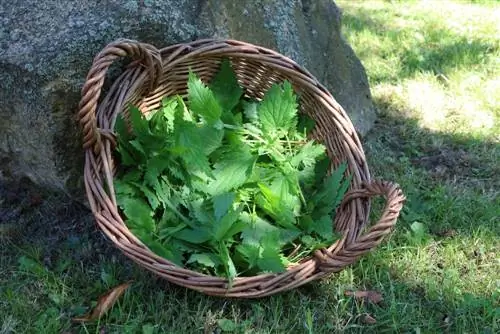
Stinging nettle infusion
Omnipresent in the natural garden in ecological plant care, nettles also fulfill their task to the fullest satisfaction as a spray in pest control. The aim of the preparation is not to let the infusion ferment for so long that it turns into manure. At this concentration the effect on the taste would be disadvantageous. How to proceed:
- Pour 500 g of nettle leaves into a bucket
- pour 5 liters of water over it
- cover with a grid to allow air to reach the mixture
In the following 2-3 days, the gradually fermenting liquid is stirred several times a day. As soon as the first air bubbles appear, the infusion is ready. Strained through a coarse sieve, the spray mixture is ready for use. Apply the nettle broth to the vegetable patch twice a week until no more damage occurs.
Conclusion
Their tiny, 7 mm long body belies the damage the onion fly can do in the vegetable garden. As soon as the first young onion, leek or chive plants emerge, the voracious larvae rob them of all vitality. By the time the second and third generations strike, the crops have already developed to the point where they can cope with an infestation. Until then, efficient sprays are sometimes unavoidable to combat high infestation pressure. If the pest is discovered early thanks to the knowledge of the profile, with a little luck biological control agents will put an end to it and its brood.

